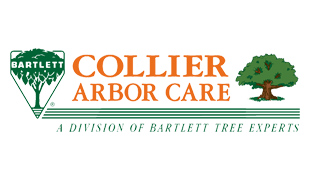|
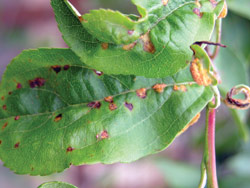
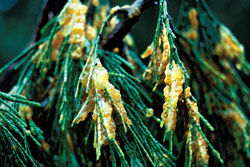
(Top) Crabapple Rust, (Above) Cedar Rust Slime RustDownload a PDF of this articleDescriptionRusts are fungal diseases that infect many hosts. Common rusts in our area include; Incense cedar-pear (and crabapple) rust, Western gall rust, rose rust, hollyhock rust. Plants AffectedBirch, cottonwood, cypress, false cypress, fuchsia, hawthorn, juniper, pine, poplar, rhododendron, rose, and spruce. Symptoms/DamageDry reddish, yellowish, or orange spore masses or pustules form on infected tissue, especially on the lower surface of leaves. The upper surface of heavily infested leaves turns yellow or brown and infected leaves may drop prematurely. Orange, gelatinous masses appear on some infected evergreen hosts. Some species cause tissue swellings or galls, colorful spots on plants, or cankers on bark. These can cause branch dieback and occasionally kill the entire plant. Some rusts may cause leaves and shoots to become distorted, dwarfed, and discolored, forming “witches broom”. Life CycleRusts have complicated life cycles. In trees they generally go from a coniferous host to an alternate host in the rose family to complete their life cycle. Spores are produced each spring, are windborne and infect other alternate hosts. Moist conditions stimulate spore release and favor infection. There are as many as 5 different spore types typical rust can produce. Western gall rust is an exception and only infects pines and has no alternate host. ManagementCulturalAvoid overhead watering, which favors spore germination Rake infected leaves or needles and clip and dispose of infected shoots and branches as soon as they appear Plant resistant varieties. There is a good list of resistant rose varieties from the Rose Society. Maintain healthy plants with proper watering and fertilization regimes to reduce overall plant stress making plants less palatable for insects. TreatmentFungicides applied in the spring can reduce some rust diseases, but frequent applications required to provide good control are generally not warranted in landscapes To control white pine blister rust, nearby alternate hosts (Ribes spp.) are sometimes removed, but the effectiveness of this is questionable |
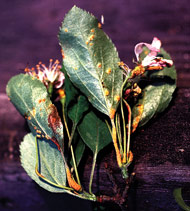
Apple Rust 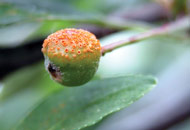
Crabapple Rust |
|
Home |
Services |
The Arbor Advisor |
Garden Calendar |
About Us |
Fact Sheets |
Contact Us |
Site Map Collier Arbor Care Portland 503-722-7267 Vancouver (360) 693-6056 Site contents and design ©2013 Collier Arbor Care |
